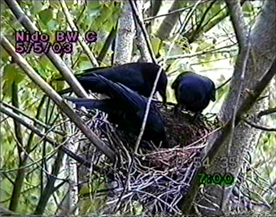| |



  
|
Cooperation at the nest
Benefits of care
We combined genetic information on parentage and relatedness among group members with video-recorded observations at the nests to determine to what extent direct and indirect fitness benefits influence individual provisioning decisions. We found that breeders fed the chicks at significantly highest rates than non breeders, which did not vary their effort according to their relatedness with the chicks. The presence of several care-givers augmented the reproductive success of the group. |
 |
Using data from 99 different territories, followed over ten years, we showed that group size was positively correlated with the annual number of fledglings produced, after controlling for the potential confounding effect of territory quality. This occurred through: (1) an increased probability for larger groups of re-nesting after early nest failure; (2) a higher probability of nest success; and (3) a higher number of fledglings produced in successful attempts. Video recorded observations at the nests showed that chicks received more food in larger groups during the first 10 days of life, when the risk of starvation is highest.
Costs of care
Provisioning the chicks is costly in terms of body mass loss. By weighting group members with a digital scale before and after the breeding season, and measuring their individual contribution to nestling care, found that both breeders and helpers lost weight (on average 5.4% of initial mass) in proportion to their provisioning effort. When territory resources were temporary enhanced during the breeding season by providing additional food, both breeders and helpers invested them in self-maintenance by reducing their body mass loss, instead of augmenting chicks provisioning rates.
However, when food availability was augmented throughout the year, helpers increased their provisioning effort during the following breeding season, while breeders did not. This indicates that year-round territory quality influences provisioning decisions, but that the trade-off between costs and benefits of care is not equal among group members. We suggest that the probabilities of reproducing in the following breeding season, which are higher for breeders than for helpers, modulate the effect of long-term resource abundance on individual decisions, determining a higher investment in the current brood by helpers, and in self-maintenance by breeders. The idea that self-maintenance is important for crow breeder is supported by the following study on false feedings.
False feedings
In carrion crows, 81.5% of the individuals that provided nestling care visited the nests without feeding the chicks (false feedings) during 16.3% of nest visits, with some individuals performing them at very high rates (up to 64% of nest visits). False feedings consisted in arriving at the nest with no food, consuming part or all the food brought to the nest, or taking back from a chick's gape the food that had just been delivered. False feedings occurred at similar rates in unassisted pairs and groups with helpers, and breeding females showed them at significantly higher rates than other group members. Furthermore, individuals showed false feedings regardless of whether they were alone on the nest or in the presence of other group members, provoking no aggression by the rest of the group. False feedings are not likely to represent deceptive help in the carrion crow, as suggested instead in other cooperative species (white-winged chough Corcorax melanorhamphos). We suggest that crows evaluate the chicks' condition during nest visits and that false feedings occur as result of a trade-off between their own hunger and the chicks' needs.
| |





